Alpine ski boot/binding systems continue to evolve. Figure 1 shows a 1940's vintage ski boot. High forward- and lateral ankle flex characterized this design which often resulted in ankle injuries because of absence of boot support and binding release function. Figure 2 shows a 1950's vintage boot with more forward and lateral ankle support with some binding release capability. The boots were made of leather and stiffness was highly dependent on ability to lace the boots and the ability of the laces to remain in position without loosening. Boots of polymer construction evolved in the late 60's and 70's with increased lateral stiffness adding to more precise edging control of skis (Figure 3). Along with the lateral stiffness came an increase in forward stiffness. This tended to reduce forward ankle flexion during skiing resulting in nearly vertical positioning of beginners and intermediate skiers. In many instances, stiff boots result in the sit-back position of Figure 4 when attempts to teach vertical motion and flexion of the lower body are made. This shifting of weight backwards is often frustrating to ski instructors since edging and other skiing skills are diminished resulting in a lack of student progress. Equipment researchers in past years have been addressing the problem of decoupling the forward and lateral stiffness of ski boot/binding systems. High lateral stiffness is necessary to insure control of ski edging. A relatively low forward stiffness is desirable to allow ankle and knee flexion. The ability to change knee and ankle flexion results in better control and better skiing. New ski boot/binding systems incorporating high lateral and low forward stiffnesses are becoming available in the market place. This article looks at such a system and analyzes the potential of these systems in allowing quicker skill development among beginner and intermediate skiers.
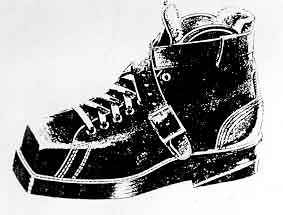 FIGURE 1
FIGURE 1
 FIGURE 2
FIGURE 2
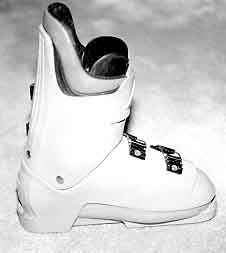 FIGURE 3
FIGURE 3
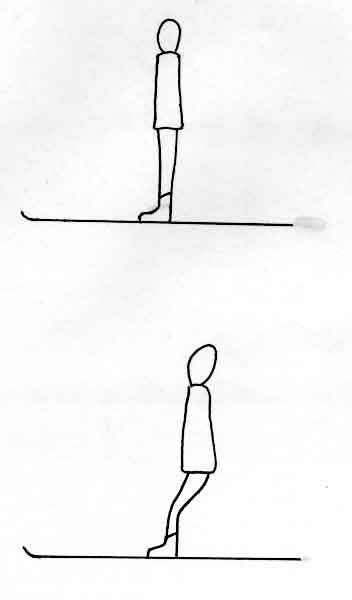 FIGURE 4
FIGURE 4
BIOMECHANICS OF ANKLE AND KNEE FLEXION
Ski instructors have often encouraged students to bend the knees and ankles to achieve appropriate edging of skis. Figure 5 reviews biomechanics of the flexed knee joint encouraged in downhill skiing. From experience we know that attempts the angulate the extended lower leg is difficult. During extension the condyles of the femur
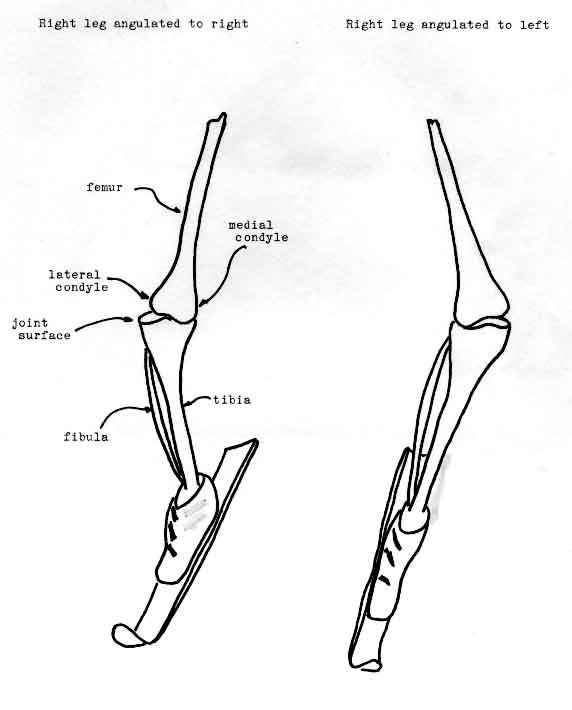
restrict movement of the knee joint laterally. When the knee joint is flexed, the condyles of the femur rotate slightly over the tibia head allowing lateral displacement of the knee joint and markedly increased ability to edge the skis. Hyper-flexed knees and ankles are a trademark of ski racers. Likewise with the beginner, flexing of the knee and ankle joints is essential for advancement and skill development. However excessive forward stiffness of the ski boot can limit ankle and knee flexion or result in the off balance positioning of Figure 4.
HIGH ANKLE FLEX SYSTEMS
Figure 6 is a view of a high ankle flex ski boot/binding system. The boot is relatively soft with a stiffness similar to that of after-ski boots. The boot by itself is characterized by a low forward and lateral stiffness. In Figure 6 we see the boot mounted on a binding along with a control arm that is in contact with the lower leg. The
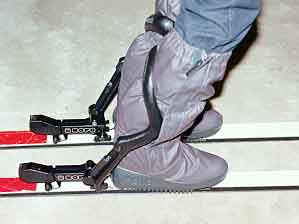 FIGURE 6
FIGURE 6
control arm is pressed against the lower leg by a spring resulting in a snug fit. The control arm increases the lateral stiffness of the system markedly with little effect on the forward stiffness. Control arm motion is dampened to absorb shock input from skiing. Release functions are controlled by a spring loaded stud that retains the ski boot.
POTENTIAL EFFECT OF BOOT/BINDING SYSTEM ON ALPINE STUDENTS
For beginning skiers who have not utilized other systems, edging and positioning skills should develop quickly when compared to students using stiff forward flex ski boots. The soft forward flex allows easy ankle flexion which is conducive to keeping the weight over the center of the ski. More ankle and knee flexion increases edging skill naturally resulting in easier transition from skidded turns to carved turns. For skiers who have utilized stiff forward flex ski boot/binding systems, the usage of a high forward flex system may require some adjustment. Beginners and intermediate skiers often ski in a sit-back position (Figure 4). High flex systems may have less backwards stiffness than typical stiff forward flex systems resulting in more excessive rearward positioning until the student becomes acclimated to the system. High forward/aft flex boot/binding systems can be expected to promote skiing over the center of the ski.
CLOSING REMARKS
Ski equipment has a significant influence on the acquisition of skiing skill. Excessively stiff ski boot/binding systems have often hampered the advancement of novice skiers. Development of the soft forward stiffness boot/binding systems has the potential of accelerating skill development in skiers and reducing the frustration of stagnation at a mediocre level.
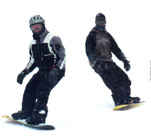 BACK TO ROBERTS SKI AND SNOWBOARD INSTRUCTION HOME PAGE
BACK TO ROBERTS SKI AND SNOWBOARD INSTRUCTION HOME PAGE